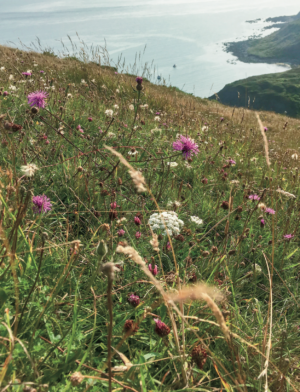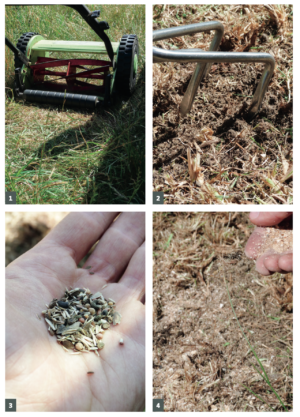Say Goodbye to Mowing: Turn Your Lawn Into a Meadow
When we think of living sustainably or ecologically, it can be easy to say to ourselves “well I don’t have the space/land for that” or “I don’t have the time”. But if you look outside your front window, you’ll see you have the perfect green space to start: your lawn. By converting your lawn into a meadow, not only can you throw away that old mower for good, but you also create a space that helps pollinators, natural plant species, and your neighborhood’s ecosystem. There’s no better time to start than the present.
The following is an excerpt from The Ecological Gardener by Matt-Rees Warren. It has been adapted for the web.
(All photography courtesy of Matt Rees-Warren unless otherwise noted.)
Wildflower Meadows
There can be little doubt that the surge of interest in wildflower meadows in recent years is due to a growing appreciation for indigenous plant species. Many have lamented their almost total loss, but many more have had to ask: What is a wildflower meadow? The answer would seem at first rather simple, with many of us able to conjure up an image of a colourful rolling pasture. And yet, as with much in the mysterious world of horticulture, everything isn’t always quite what it seems. Meadows can take on many novel forms and although they can sometimes look similar, they have vastly different means of survival.
The most distinctive difference is between those that are natural and those that are manipulated by human and animal intervention. Natural meadows are areas of ground that usually experience harsh climatic conditions that resist the normal successional formation of forests. They might occur above the treeline in the mountains, along the salt- and wind-lashed coastline, or in areas of severe drought and fire such as deserts or prairies. These specific environments
– sometimes called perpetual meadows – are the perfect places for perennial grasses and wildflowers to make their own and, over many thousands of years, create highly diverse sustainable habitats. Natural meadows can also form as successional stages where a previously forested area suffered a disturbance – a fire, for instance – but these will only ever be fleeting and are sometimes called transitional meadows. All other meadows that we are likely to see were formed by human intervention.

A coastal meadow prevailing where other plants cannot.
It all begins with agriculture, and the way our early farming ancestors, by chance or design, managed to marry these two distinct types of meadows together. First, they created a transitional meadow by clearing the land of trees and scrub through burning or felling, and then mimicked the perpetual meadow by establishing grazing patterns for their livestock to stop the forest ever forming again. Why hasn’t the type of grazing still practised the world over today – in a far more intensive form – not resulted in a world full of wildflowers meadows, then? Because wildflower meadows require a delicate balance between over- and under- grazing. Traditionally, another stage of agricultural production, hay-making, helped strike this balance. To feed and sustain a population of livestock year-round on grass, the traditional method was to allow some fields to go ungrazed through the spring and early summer, and then cut in late summer for hay that could be fed through the winter. This would give perennial flowers and grasses the chance to reach their potential within the year, and as farmers left these fields like this for many hundreds of years, they became, in essence, managed perpetual wildflower meadows. The key to the meadows’ species diversity lay in the fact that this method depletes the soil of nutrients due to the full growth of the plants, much like growing crops would; therefore, over time, grasses began to yield to more adventitious wildflowers that fared better in the nutrient-poor soil. Unfortunately, farming practices changed completely after the Second World War, with the introduction of herbicides, faster growing grass species and silage production, all combining to eradicate the late summer hay-cut, and, as such, meadows disappeared in line with these changes.
This history is vitally important before we embark on creating our own wildflower meadows, and so too is one further distinction. Meadows are always perennial, but they have a close relative in annual cornflowers. Once again, agriculture laid the path for their prosperity by producing arable land for crop growing. The soil is first ploughed to remove all vegetation, and this bare earth induces the flowering of a vast seed bank that has been waiting patiently for its moment to break out of dormancy. As this cyclical ploughing persisted, so too did an ever more diverse population of annual species benefiting from the lack of competition from their perennial cousins. The farmers saw these species as only weeds, taking away from their designated crop, and once again changed their methods, resulting in the disappearance of arable wildflowers. We need to realise this difference, as an annual cornflower field requires annual ploughing to induce the seed into flowering and is not a meadow at all. This is counter to the methodology for creating a wildflower meadow, which requires absolutely no ploughing whatsoever – an important distinction to remember!
If understanding the difference between wildflower groups is vital, this pales into insignificance beside knowing what a wildflower meadow does for the natural world and ultimately why we would want to restore and recreate this habitat. Meadows offer a wealth of sustenance and habitat for wildlife, but perhaps more importantly they are evocative and beautiful to us. Much of wildlife habitat can be rough and scraggly, but wildflower meadows are like paintings of loose expression and colour, which, combined with what they provide to the natural world, makes them feel like the perfect blend of human and wild creation.
Making Meadows
Deciding which species to sow in your meadow is one of the first steps, and although this can be daunting, there are general seed collections to guide you. However, your site will always have variations of soil, aspect, water drainage and microclimate that are unique from any other, so it’s worth researching the correct mixture of species suitable to your conditions. Also, in the centuries that wildflower meadows were present in the landscape, a dazzling diversity of species took hold that became quite specialised to certain local regions. Many of these species are now either extinct or critically endangered, so seeking out the latter will not only restore a lost heritage but also engender a wider amount of biodiversity within the meadow. Common wildflower meadow species include: meadow buttercup (Ranunculus acris), ox-eye daisy (Leucanthemum vulgare), greater knapweed (Centaurea scabiosa), lady’s bedstraw (Galium verum), meadow foxtail (Alopecurus pratensis), meadow brome (Bromus commutatus) and sweet vernal grass (Anthoxanthum odoratum).
Wanderlust will only take you so far though, and with meadows it’s really only time and labour that will yield results. A wildflower meadow can be grown anywhere and be of any size, but why not start with the grassy sward many of us already possess: a lawn? A lawn is a type of meadow, albeit a rather strange one with unusual species in it, so it seems only logical to reimagine it as a wildflower meadow.
Turning a Lawn Into a Wildflower Meadow

Figures 1-4
The first thing to do is ditch the mower and let the grass grow long. You’ll then be able to see which indigenous species already exist within the lawn. This will throw up some surprises – good and bad – and it’s critically important to make a note of what is there. It’s more than likely that grasses will be extremely dominant, and if we left the meadow at this ratio, we would only ever be growing long grass. So when the summer ends and autumn falls in, we need to take the lawn to task and start turning it into a wildflower meadow. The reason for sowing in the autumn and not the spring is that most of the species release their seed at this point naturally, and some even need a period of winter cold to break their dormancy. It also increases their chances of developing a seedling before the dominant grasses take hold in the spring.
- In the autumn, cut the lawn to the absolute lowest your mower or scythe will allow. Go over the lawn a few times, lowering the height after each pass (figure 1).
- Depending on the size of the area, using either hand or machine, scarify or harrow the lawn until 80 per cent of the existing grass is ripped out.
- Rake this up and remove. Expose bare soil in which seeds can germinate (figure 2).
- Source a 100 percent (no grass) indigenous wildflower seed mix of perennial species and sow at the recommended rate (figure 3). Mix the seed with sand so you can see where you’ve sown (figure 4).
- Press the seed firmly into the ground by walking over it, using a weighted roller or tracking over it with vehicle tyres.
Recommended Reads
https://www.chelseagreen.com/2021/15-questions-design-garden/
